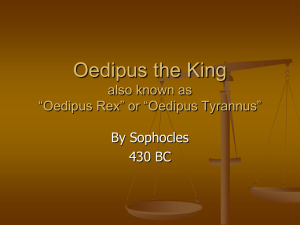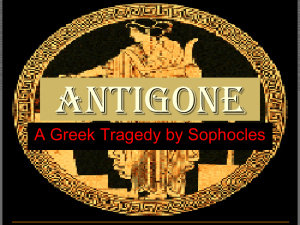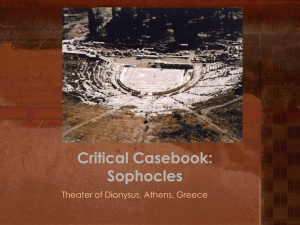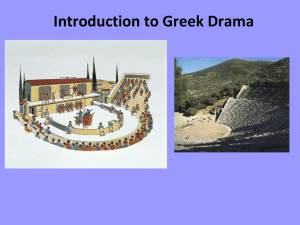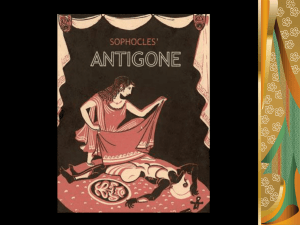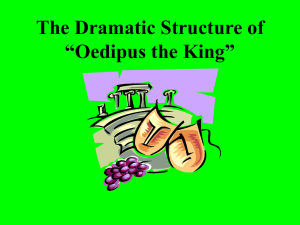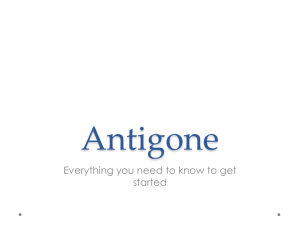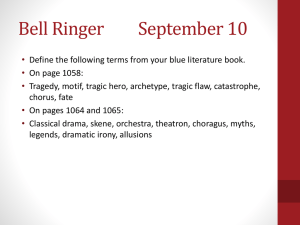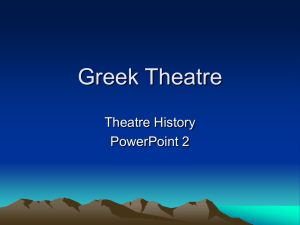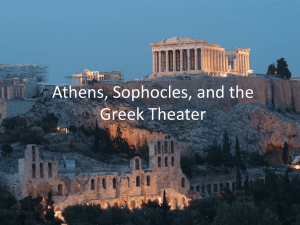Greek Drama - Madison Central High
advertisement
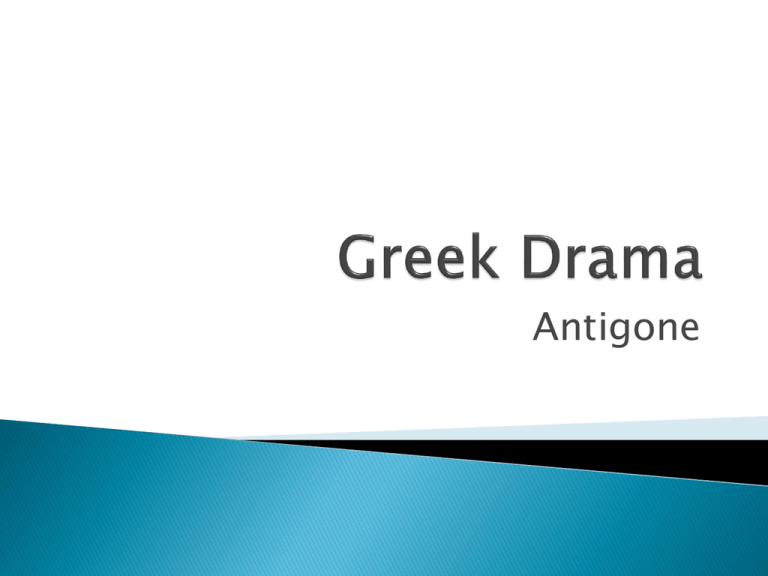
Antigone 5th Century BC Golden Age of Drama Dramatic festivals were popular People watched tragic and comic plays This period referred to as the Age of Pericles This Golden Age ended with the start of the Peloponnesian War Earliest literary genre in Athens = poetry, which appeared as early as the twelfth century BC Poetic tradition continued via tragedies Greek tragedy developed from the dithyramb, a combination of dance and song performed by a chorus in honor of Dionysus (god of wine, fertility, theater) Worship of Dionysus began as a choral song performed by a chorus of 50 men dressed in goatskins “Tragedy” comes from the Greek for goat Roots in Worship of Dionysus God of wine and Revelry Invention of tragedy attributed to Thespis Created the first actor (hypokrites) who performed between the dances of the chorus In 534 BC tragedy was introduced into the festivals of Dionysus, which occurred three times a year in Athens The largest of these festivals called the Great Dionysia The best of the plays called Attic plays The "inventor of tragedy" was born in Attica The first prize winner at the Great Dionysia in 534 BC. He was an important innovator for the theatre, introduced: the independent actor, masks, make up, costumes Thespis walked around Athens pulling a handcart, setting up a kind of one man play, where he showed the bad behavior of man. The word for actor " thespian" comes from his name. His contemporary Solon resented him, with the claim that what Thespis showed on stage would soon be acted out in reality as well. Subject matter – similar to that of epic poetry – history and mythology Audience was very familiar with the subject and knew the ultimate fate of the characters Main interest was in how the playwright adapted and interpreted the material The Three Types of Greek Drama Comedy: Like tragedy, developed through worship of Dionysus The first comedies were mainly satirical and mocked men in power for their vanity and foolishness. The first master of comedy was the playwright Aristophanes wrote . Only ten plays Much later Menander wrote comedies about ordinary people and made his plays more like sit-coms. The Three Types of Greek Drama Tragedy: Tragedy dealt with the big themes of love, loss, pride, the abuse of power and the fraught relationships between men and gods. Typically the main protagonist of a tragedy commits some terrible crime without realizing how foolish and arrogant he has been. Then, as he slowly realizes his error, the world crumbles around him. The three great playwrights of tragedy were Aeschylus, Sophocles, and Euripides. Aristotle argued that tragedy cleansed the heart through pity and terror, purging us of our petty concerns and worries by making us aware that there can be nobility in suffering. He called this experience 'catharsis'. The Three Types of Greek Drama Satyr Plays: These short plays were performed between the acts of tragedies and made fun of the plight of the tragedy's characters. The satyrs were mythical half human, half-goat figures and actors in these plays wore large phalluses for comic effect. Few examples of these pays survive. They are classified by some authors as tragicomic, or comedy dramas. A Satyr & Dionysus A Satyr & a Nymph Hubris Hubris or hybris (Greek ὕβρις), according to its modern usage, is exaggerated self pride or self-confidence (overbearing pride), often resulting in fatal retribution. In Ancient Greece, "hubris" referred to actions taken in order to shame the victim, thereby making oneself seem superior. Hubris was a crime in classical Athens. The category of acts constituting hubris for the ancient Greeks apparently broadened from the original specific reference to molestation of a corpse, or a humiliation of a defeated foe, to molestation, or "outrageous treatment", in general. The meaning was further generalized in its modern English usage to apply to any outrageous act or exhibition of pride or disregard for basic moral law. Such an act may be referred to as an "act of hubris", or the person committing the act may be said to be hubristic. Hubris Another example is that of Oedipus. •In Oedipus the King, while on the road to Thebes, Oedipus meets King Laius of Thebes who is unknown to him as his biological father. Oedipus kills Laius out of hubris over which has the right of way, thereby fulfilling the prophecy of the oracle Loxias that Oedipus is destined to murder his own father. •Creon commits hubris in refusing to bury Polynices in Sophocles' Antigone. Fate FATE: the will or principle or determining cause by which things in general are believed to come to be as they are or events to happen as they do : destiny The Greeks believed that everything happened for a reason and that the path they led in life, was prescribed for them by the Gods and that there was no escaping their fate or destiny. Irony & Dramatic Irony IRONY: a pretense of ignorance and of willingness to learn from another assumed in order to make the other's false conceptions conspicuous by adroit questioning DRAMATIC IRONY: incongruity between a situation developed in a drama and the accompanying words or actions that is understood by the audience but not by the characters in the play —called also dramatic irony or tragic irony Ritual and Theatre The Evolution of Actor-Audience Relationship Agrarian and Fertility RitesEarly cultures tried to find ways to appease the seemingly supernatural or godlike forces that controlled the food supply. Stories began to grow out of the "performance" of the ritual to explain why the ritual was important. As humanistic thought and knowledge developed, rituals became less important for ensuring food and fertility for the society. Like modern Theatre, these rituals contained enactment, imitation and seasonal performances Entertainment is a bonus for the ritual audience; the goal is to gain prosperity from the gods. Modern Theatre must entertain. photo by Melissa Byrd The Evolution of the Early Theatrical Space From Religious Ceremony to Performance The famous Dionysan theatre was built into the mountain that housed the famed Acropolis. The Dionysia was a spring celebration of the fertility god Dionysus – known as the Festival of Dionysus The last 3 days of the festival was dedicated to 3 writers and their tragedies. The winner received a lily wreath. Famous competitors: Aeschylus, Sophocles and Euripedes. Day 1 – proagon – plays announced Day 2 – processions, parades, sacrifices Day 3 – performance of the first five comedies Day 4-6 – performance of tragedies Day 7 – judging and awards Aeschylus – used two men as actors; one talking to the other Sophocles – used three actors; each played several parts Euripedes – used even more actors; angered the Greeks because he showed the Greeks and gods in a sometimes negative light as they really were; portrayed strong female character; killed by wild dogs Men only -- one actor played several parts wore high-heeled boots to add stature masks often fitted with megaphones theatron – the theatre skene – changing room altar – middle of stage chitons – brightly colored robes onkoi – wigs kothurnoi – shoes on small stilts masks – had built in megaphones for amplification; masks for comedies were always def Two major performance areas- The Orchestra or “Dancing Circle” served as the primary acting area The Skene (scene building)- consisted of a building behind the orchestra probably used as a dressing room, later to be integrated into the stage action by an innovative playwright. Greek Scenic Devices Periaktoia revolving triangular devices with one scene painted on each side. Deus ex Machina“God From the Machine” The Machina- a crane that was used to represent characters who were flying or lifted off of the earth. Tunnel from behind the Skene to the center of the stage. Scenic wagons revealed through doors on the Skene. Pinakes painted panels that could be attached to the skene. Where and how were the dramas performed? …In an amphitheatre …With a chorus who described most of the action. …With masks …With all the fighting and movement going on off stage. ….With tragedy first, then comedy later. The Greek Chorus The chorus was dominant because there was usually one actor and that actor had to leave the stage several times during a show to change characters. The chorus was to be a representation of society, they often served as the “ideal spectator” by providing advice, opinions, questions to the audience and actors. The main actor(s) stood apart in the performance space because they typically played heroic figure that would realistically be separated from normal mortal beings. Their costumes and masks added spectacle and their movement and dance heightened the dramatic effect. Great actors were characterized by their voice quality and the ability to adopt their manner of speaking to the character. Greek and Roman Theatre share the following elements: A facade stage- actors performed in front of a neutral background Relationship with religion- plays were presented as part of a larger celebration Special Occasion- theatre was held on special occasions and not often enough to be taken for granted. Noncommercial environment- the wealthy citizens or the state picked up the costs as part of the obligation of citizenship. Male-only performerswomen sat in the audience only. Theatres were built into sides of hills so that they could harness the natural acoustics. Restored during the 1950’s. Can accommodate an audience of 14,000 Used for modern performances of ancient drama. Masked actors performed outdoors in daylight before audiences of 10,000 or more at festivals. Masks made actors more visible. Masks were used to show facial expression. This helped to identify the character to the audience. The use of masks enabled 1 actor to play several parts in one play. Victorian excavations of Pompeii revealed what might be considered ancient wallpaper illustrating dramatic masks. Mouthpieces in the masks helped the acoustics of the performance. Roman Actors with their masks Some general categories of masks 1. OLD MEN Smooth-Faced, White, Grizzled, Black-Haired, Flaxen and More Flaxen 2. YOUNG MEN Common, Curled, More Curled, Graceful, Horrid, Pale and Less Pale 3. SLAVES Leathern, Peaked-Beard, Flat Nose 4. WOMEN Freed Old Woman, Old Domestic, Middle Aged, Leathern, PaleDisheveled, Pale Middle Aged, Whorish-Disheveled, Virgin, Girl 5. SPECIALIST MASKS Some made for specific characters, others for: Mourning, Blindness, Deceit, Drunkenness...etc. (The comic masks, those especially of old comedy, were as like as possible to true persons they represented, or made to appear more ridiculous) No censorship of events. However, Greeks were very polite on stage. all spectacular action (death, murder, adultery) happens off stage -- only described. set the tone recall events from the past represents the feelings or morals of the characters or audience gives important background information interprets and summarizes events comments on action gives advice to the characters ask questions give opinions, if asked stay objective—did not disagree with leading actor act like a jury of elders and reach a moralistic conclusion Prologue: a preface or an introduction Parados: marks the entrance of the Chorus when they first enter Stasimon: songs the Chorus sings in Greek tragedy between episodes Episode: the main action of the play; in Greek drama it refers to that part of a tragedy presented between two stasimons Exodus: conclusion of the play Exeunt: another word for “Exit” Time – real time Place – all in one place Action – continuous action in one place Aeschylus 524 B.C. Seven Against Thebes Sophocles 496 B.C. Antigone Oedipus Euripides 480 B.C. Medea Dramatist Born Wrote Sophocles: The Three Theban Plays (Oedipus Rex) Sophocles: (496- 406 B.C.E.) •He wrote 123 or more plays during the course of his life •For almost 50 years, he was the dominant competitor in the dramatic competitions of ancient Athens that took place during the religious festivals of the Lenaea and the Dionysia. •His first victory was in 468 BC, although scholars are no longer certain that this was the first time that he competed. Sophocles: (496- 406 B.C.E.) Sophocles: The Three Theban Plays (Oedipus Rex) Sophocles: (496- 406 B.C.E.) •Only seven of his tragedies have survived into modern times with their text completely known. •The most famous of these are the three tragedies concerning Oedipus and Antigone: these are often known as the Theban plays or The Oedipus Cycle, (Oedipus the King, Oedipus at Colonus, & Antigone) although they were not originally written or performed as a single trilogy. •Sophocles influenced the development of the drama, most importantly by adding a third character and thereby reducing the importance of the chorus in the presentation of the plot. •He also developed his characters to a greater extent than earlier playwrights such as Aeschylus. Sophocles: (496- 406 B.C.E.) Sophocles: The Three Theban Plays (Oedipus Rex) Background: •Plays are set in Thebes (General Overview) •Oedipus the King: •Oedipus unknowingly kills his father, King Laius, marries his mother and fathers four children with her. •Upon discovering he murdered his father, he gouges his eyes out; Jocasta commits suicide; Creon (Jocasta’s brother) becomes King of Thebes and banishes Oedipus •Oedipus at Colonus: •Antigone cares for her blind father •Oedipus’s sons (Polynices & Eteocles) fight over control of Thebes and kill eachother in Battle; Oedipus mysteriously dies •Antigone: •Antigone and sister Ismene try to persuade Creon to properly bury Polynieces, but refuses; Antigone commits suicide as well as Creon’s wife after she sees her dead son in the arms of Creon Sophocles: (496- 406 B.C.E.) Use of dramatic irony Acted in daytime without lights or curtains, few sets Actors were male; wore masks, wigs, and high boots—all this added to the formality Written in poetic verse rather than prose Observed the three unities—time, place, subject Messengers used to tell audience about events off stage—no violence shown on stage Use of chorus—leader called Choragus The Storyline Central Character is of the Elite Class Central Character suffers a Downfall Central Character is Neither Wholly good nor wholly evil Downfall is the result of a TRAGIC Flaw Misfortunes involve characters who are related or who are friends Tragic actions take place offstage Central Character has a moment of recognition Audience experiences pity and fear Pity and Fear leads to a catharsis The End
